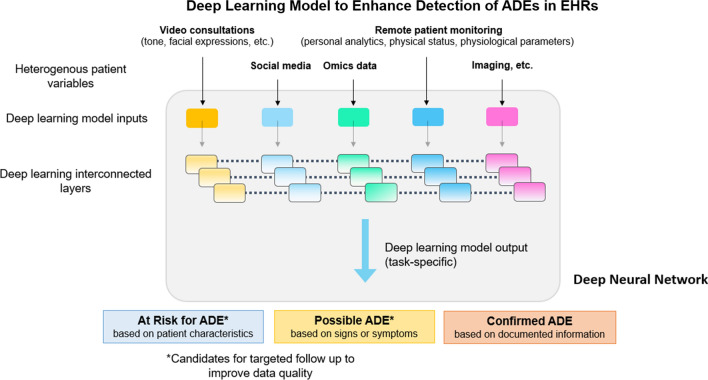Fig. 1.
Advantages of deep learning for pharmacovigilance. The outcome of the model can be the high-risk patient population for future adverse drug events (ADEs) or specific types of ADEs, or patients’ responses to treatment. The data sources, both clinical and genetic variables, were shown to be able to contribute to the prediction performance, suggesting the advantages of integrating different types of input data for model development. Among different model types, the traditional regression model, given its better interpretability compared with more complicated machine learning approaches, can be limited by the number of input features. Different model types based on machine learning, including support vector machine and tree-based models, however, showed better predictive power in some recent studies [42, 43]. Deep learning, a subset of machine learning that refers to algorithms using complex neural networks with many hidden layers, was also applied for ADE prediction. In recent studies, deep learning-based algorithms showed superiority over other methods [44]. This is due to increasingly available large datasets and the ability to identify complex non-linear patterns using deep learning models. However, because of their complexity, the algorithms may be non-interpretable to the human brain and are considered black boxes [45, 46]. Factors other than genetic predispositions, such as age, polypharmacy, or environmental factors, can contribute to ADEs [47, 48]. Collecting a large amount of data from many sources may be beneficial for prevention, as it could fully exploit differences in characteristics between patients. However, not all machine learning methods are appropriate for processing potentially high-dimensional (e.g., genomic and phenotypic data, chemical information of drugs, clinical notes, environmental data) and heterogeneous datasets. Deep learning can transform the basic (raw input) representations of a patient at a higher level and can perform automatic feature extraction from big data containing incomplete and noisy information. Even though the lack of interpretability is still a major issue, deep learning can also be used to discover intricate patterns in large data sets [49, 50]. With these advantages, deep learning could help overcome some of the barriers responsible for underreporting in pharmacovigilance. EHRs electronic health records

